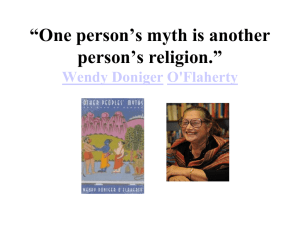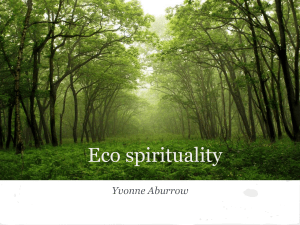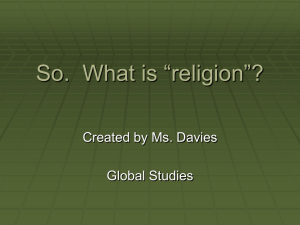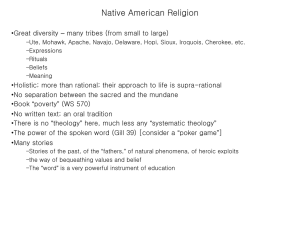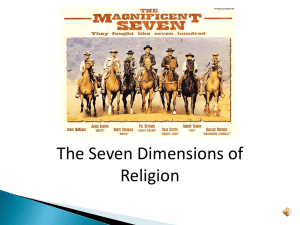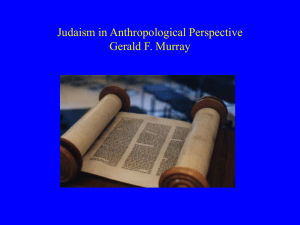Sacred Space
advertisement
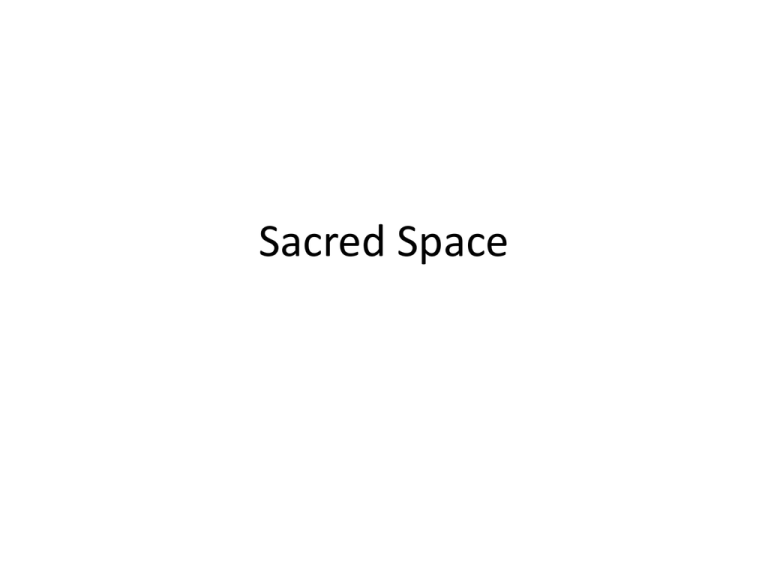
Sacred Space
A typology of sacred place
– Sacred
• Ecclesiastical (houses of god)
– Houses of God (Church, Temples, etc.)
– Gateways, altars, paths, shrines
– Pilgrimage routes
• Domestic
– Homes, gardens, lawns
– Objects; symbols
• Civic
– Monuments
– Memorials
– Entire cities (Jerusalem, Rome; Temple city complex)
• Natural
– Mountains, springs, rivers, etc.
– Profane
Ritual/Architectural Priorities (Lindsay
Jones)
•
•
•
•
•
•
•
•
•
•
•
•
•
•
•
•
•
I. Orientation
- homology
- conventions
- astronomy
II. Commemoration
- divinity
- sacred history
- politics
- the dead
III. Ritual Context
- theatre
- contemplative
- spectacle
- propitiation
- sancturary
Egyptian Pyramids
Rise and Fall of Ancient Israel
•
•
•
•
Birth of a nation; relation to land
Spatial metaphors, images
Exile; diaspora; home/geopiety
“The Lord God will restore your fortunes, and have compassion
upon you, and he will gather you again from all the peoples
where the Lord you God has scattered you… the Lord God will
bring you into the land which your ancestors possessed, that you
may possess it; and he will make you more prosperous than your
ancestors (Deut 30:3-5).
• Two great national disasters
– 536 BCE – Babylonian Conquest – Ezekiel (visionary temple)
– Return; second temple (Herod exapnds, lavishes attention)
– Rome, 70CE - Diaspora
Rivers of Babylon
Psalm 137:
By the rivers of Babylon, there we sat down.
Yes, we wept, when we remembered Zion.
We hung our harps on the willows there.
For there those who led us captive asked us for songs.
Those who tormented us demanded songs of joy:
“Sing us one of the songs of Zion!”
How can we sing Yahweh’s song in a foreign land?
If I forget you, O Jerusalem,
may my right hand forget its cunning.
May my tongue stick to the roof of my mouth
if I do not remember you;
if I do not prefer Jerusalem above my highest joy.
Remember, Yahweh, the children of Edom,
on the day of Jerusalem;
who said, “Burn it down!
Burn it even to its foundation!”
Daughter of Babylon, doomed to destruction,
he will be happy who rewards you,
as you have served us.
Happy shall he be,
who takes your little ones and dashes them on the rock.
Arad Temple Complex
Eliade
•
•
•
•
hierophany –manifestation of the sacred –
a hierophany is a mythico-historical event
revealing some attitude a people have
toward the sacred; theophanies, signs,
thresholds, gateways; in the western
monotheisms, the holiness of a place
tends to be a quality acquired through
becoming in history a place of divine
manifestation rather than an inherent
quality it has had from primeval times, in
the landscape
axis mundi - gateway between this world
and the realm of the sacred
imago mundi - an image of the world
homologized space – imago mundi architectural space resembles the sacred;
likeness in structure; consecration =
repetition of cosmology (tabernacle
modeled on, for example, “heaven”
Sacred and Profane
The ark of the Lord of Israel, containing the stone tablets of the Ten
Commandments, was kept hidden in the tabernacle (or tent of
worship) because it was the place of communion with God (Exodus
25:22). Yet the high priest was warned to take ritual precautions,
when he entered the Holy of Holies once a year on the Day of
Atonement, so that his body could be retrieved if he were struck
dead in the encounter with the presence of God (Exodus 28:33–35,
42–43).]Because religious people desire to live near the center of
the world, “the navel of the earth” (44), they build even their
houses as microcosms. To be in such a home, then, is to be at the
center of the universe, with access to the transcendent.
{Homologies}
Since many different forms of building can reflect the cosmic
model, however, religious people recognize a “multiplicity of
centers.” They seek to reiterate the image of the world in the
settling of territory, as well as in the construction of cities, temples,
and dwellings.
Eliade concludes: “In extremely varied cultural contexts, we
constantly find the same cosmo-logical schema and the same ritual
scenario: settling in a territory is equivalent to founding a world”
(47).
Critique of Holy/Sacred Sites
•
God is really present in particular places-as we have noted earlier; BUT: there is
another strand in Hebrew thinking that claims that God will not dwell in temples
•
God's real presence and his equally real freedom to be absent from his temple
•
Solomon declares, 'I have surely built thee a house of habitation, a place for thee
to dwell in forever' (1 Kgs 8.13), but-in almost the same breath-questions that
same programme: 'But will God in very deed dwell on the earth? Behold, heaven
and the heaven of heavens cannot contain thee; how much less this house that I
have builded!' (v. 27).
•
Prophetic literature - a critique of particular holy places. Such a critique
undermines their very status as holy places.
•
It cannot be denied that 'the place' was chosen by Yahweh; but it is possible to
criticize what the place has become, and attack that which denies its legitimacy as
a holy place now. This is a prophetic action.
Politics/Contestation
• Critiques of de-politicized, essentialized work of Eliade
• David Chidester; Edward Linenthal
• emphasizing a situational analysis. (Emile Durkeheim—sacred
representative of social structures, hierarchical, stratified, social
power – sacred is produced. Primary means – narrative, material
culture, ritual).
• Strategic concerns: appropriation, exclusion (dominate space by
advancing special interests or notion of purity) & inversion,
hybridization (strategies of resistance).
Eliade
Chidester and Linenthal
Sacred space set apart
Sacred space entangled
Sacred space (center) allows for passage; mediates
Sacred space mediates other social realities: political,
mythological or theological ‘levels’ or ‘domains’
gender, economic; hierarchical relations of domination
& subordination
Sacred space is a revelation (hierophany)
Sacred space the product of ‘symbolic labor’; it is
made, and therefore ‘interested’ & ‘contested’ space;
an ‘arena of signs & symbols’
Jerusalem
II. Commemoration
- divinity
- sacred history
- politics
- the dead
Civil Religion
Horatio Greenhough, 1841 - mixed reviews; in Smithsonian since 1908.
Monuments and Ideology
Monumentality… always embodies and imposes a clearly intelligible
message. It say what it wishes to say—yet it hides a good deal more.
- Henri Lefebvre
[h]istorical monuments and civic spaces as didactic artifacts were treated
with curatorial reverence. They were visualized best if seen as isolated
ornaments; jewels of the city to be place in scenographic arrangements
and icongraphically composed to civilize and elevate the aesthetic tastes
and morals of an aspiring urban elite. This was an architecture or
ceremonial power whose monuments spoke of exemplary deeds, national
unity, and industrial glory. – Christine Boyer, City of Collective Memory
Wittenberg Town Map
Schlosskirche (Castle Church - politics)





